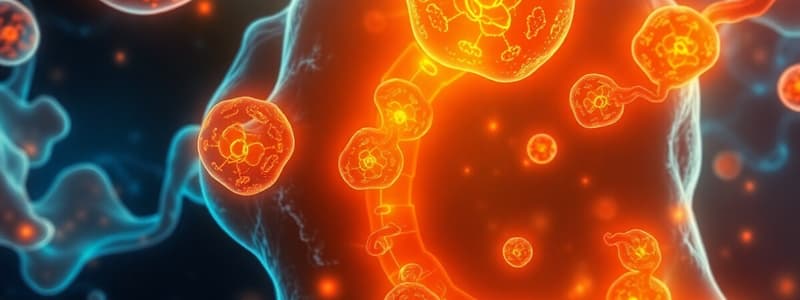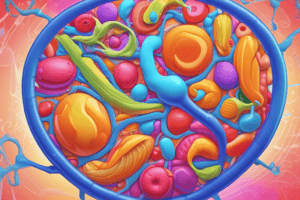Podcast
Questions and Answers
How many ATP molecules are produced per Acetyl-CoA in the fatty acid oxidation process?
How many ATP molecules are produced per Acetyl-CoA in the fatty acid oxidation process?
- 4 ATP
- 2 ATP
- 1 ATP (correct)
- 3 ATP
Which compound is primarily condensed with oxaloacetate (OAA) to start the TCA cycle?
Which compound is primarily condensed with oxaloacetate (OAA) to start the TCA cycle?
- Malate
- Citrate
- Acetyl-CoA (correct)
- Fumarate
What is the role of NADH and FADH2 produced in the TCA cycle?
What is the role of NADH and FADH2 produced in the TCA cycle?
- To donate electrons to the electron transport chain (correct)
- To directly produce ATP
- To regenerate oxaloacetate
- To facilitate glycolysis
Which process directly converts pyruvate into Acetyl-CoA before it enters the TCA cycle?
Which process directly converts pyruvate into Acetyl-CoA before it enters the TCA cycle?
What is produced during the oxidation of one molecule of Acetyl-CoA in terms of reducing equivalents?
What is produced during the oxidation of one molecule of Acetyl-CoA in terms of reducing equivalents?
In which part of the cell does β-oxidation occur?
In which part of the cell does β-oxidation occur?
Which step signifies the removal of carbon atoms during the TCA cycle?
Which step signifies the removal of carbon atoms during the TCA cycle?
What is the final outcome of the electron transport chain in mitochondria?
What is the final outcome of the electron transport chain in mitochondria?
What is the primary molecule produced during glycolysis from glucose?
What is the primary molecule produced during glycolysis from glucose?
What is the primary role of the electron transport chain in oxidative phosphorylation?
What is the primary role of the electron transport chain in oxidative phosphorylation?
How many molecules of ATP can theoretically be produced from one molecule of glucose during cellular respiration?
How many molecules of ATP can theoretically be produced from one molecule of glucose during cellular respiration?
What role does Pyruvate Dehydrogenase play in mitochondrial metabolism?
What role does Pyruvate Dehydrogenase play in mitochondrial metabolism?
Which component of the electron transport chain uses O2 as a substrate?
Which component of the electron transport chain uses O2 as a substrate?
Which of the following correctly describes the role of mitochondria in calcium homeostasis?
Which of the following correctly describes the role of mitochondria in calcium homeostasis?
Which statement about FADH2 is correct in the context of ATP yield?
Which statement about FADH2 is correct in the context of ATP yield?
Which process is primarily indicated by the term 'cataplerosis' in relation to mitochondrial function?
Which process is primarily indicated by the term 'cataplerosis' in relation to mitochondrial function?
What is the net energy yield from one molecule of glucose during glycolysis?
What is the net energy yield from one molecule of glucose during glycolysis?
What is the primary function of ATP synthase in the mitochondria?
What is the primary function of ATP synthase in the mitochondria?
What is the result of the mitochondrial membrane potential during oxidative phosphorylation?
What is the result of the mitochondrial membrane potential during oxidative phosphorylation?
Which complexes are involved in pumping protons into the intermembrane space?
Which complexes are involved in pumping protons into the intermembrane space?
What is one of the major roles of mitochondria beyond ATP production?
What is one of the major roles of mitochondria beyond ATP production?
In cell signaling pathways, how is energy from the mitochondrial processes typically utilized?
In cell signaling pathways, how is energy from the mitochondrial processes typically utilized?
Which statement is true regarding the flow of electrons in the electron transport chain?
Which statement is true regarding the flow of electrons in the electron transport chain?
What is the net ATP yield from mitochondrial NADH during cellular respiration?
What is the net ATP yield from mitochondrial NADH during cellular respiration?
Which process significantly impacts the net ATP yield from cytosolic NADH?
Which process significantly impacts the net ATP yield from cytosolic NADH?
In oxidative phosphorylation, what is the typical ATP yield from FADH2?
In oxidative phosphorylation, what is the typical ATP yield from FADH2?
What role does ATP play in cell signaling?
What role does ATP play in cell signaling?
Which of the following statements is true regarding the function of ATP?
Which of the following statements is true regarding the function of ATP?
What mechanism does the mitochondria utilize for anabolic processes?
What mechanism does the mitochondria utilize for anabolic processes?
How much free energy is released during the hydrolysis of one mole of ATP?
How much free energy is released during the hydrolysis of one mole of ATP?
Which of the following statements regarding oxidative phosphorylation is incorrect?
Which of the following statements regarding oxidative phosphorylation is incorrect?
What is the primary purpose of ATP in active transport mechanisms?
What is the primary purpose of ATP in active transport mechanisms?
What is the range of ATP production typically observed per glucose molecule during glycolysis and oxidative phosphorylation combined?
What is the range of ATP production typically observed per glucose molecule during glycolysis and oxidative phosphorylation combined?
What primarily regulates the permeability of the inner mitochondrial membrane?
What primarily regulates the permeability of the inner mitochondrial membrane?
What is the main role of mitochondrial DNA (mtDNA) in the context of energy production?
What is the main role of mitochondrial DNA (mtDNA) in the context of energy production?
How does the presence of cristae in the inner mitochondrial membrane affect ATP production?
How does the presence of cristae in the inner mitochondrial membrane affect ATP production?
During oxidative phosphorylation, which of the following processes occurs?
During oxidative phosphorylation, which of the following processes occurs?
Which process allows for the selective removal of dysfunctional mitochondria within cells?
Which process allows for the selective removal of dysfunctional mitochondria within cells?
What role do ribosomes in the mitochondrial matrix play?
What role do ribosomes in the mitochondrial matrix play?
What key function does the porin (VDAC) protein serve in mitochondria?
What key function does the porin (VDAC) protein serve in mitochondria?
How does mitochondrial fission influence cellular metabolism?
How does mitochondrial fission influence cellular metabolism?
What is a primary consequence of maternal inheritance of mitochondrial DNA?
What is a primary consequence of maternal inheritance of mitochondrial DNA?
Which metabolic process occurs within the mitochondrial matrix?
Which metabolic process occurs within the mitochondrial matrix?
Flashcards are hidden until you start studying
Study Notes
Carbohydrate (Fatty Acid) Metabolism in the Mitochondria
- Mitochondria are the powerhouses of the cell, involved in vital processes including energy production (ATP), anabolism, calcium homeostasis, and apoptosis.
- TCA/Krebs/Citric Acid Cycle is a key step in cellular respiration, occurring in the mitochondrial matrix.
- The cycle starts with the condensation of Acetyl-CoA (2 Carbons) with oxaloacetate (OAA; 4 C) to form citrate (6 C).
- During the cycle, 2 carbons are lost as CO2, regenerating OAA.
- The cycle produces 4 pairs of electrons carried by NADH and FADH2.
- These electron carriers are then transported to the electron transport chain.
- Glycolysis is an anaerobic pathway that occurs in the cytosol, breaking down glucose into pyruvate.
- It produces 2 ATP, 2 NADH, and 2 Pyruvate per glucose molecule.
- Pyruvate can be further catabolized aerobically or anaerobically.
- PDH (Pyruvate Dehydrogenase) is a multienzyme complex that transforms and transports pyruvate into the mitochondrial matrix.
- It decarboxylates pyruvate to form a 2-carbon acetyl group.
- The acetyl group is transferred to Coenzyme A (HS-CoA) to produce Acetyl-CoA.
- This process requires NAD+ and produces NADH.
- The overall reaction is: Pyruvate + HS-CoA + NAD+ → Acetyl-CoA + CO2 + NADH + H+
- β (Fat)-Oxidation is a stepwise process that breaks down fatty acids in the mitochondrial matrix.
- It produces Acetyl-CoA, which can then enter the TCA cycle.
- It also generates reducing equivalents (NADH and FADH2).
Oxidative Phosphorylation
- Electron Transport Chain is located in the inner mitochondrial membrane, utilizing electrons from NADH and FADH2.
- These electrons pass through a chain of protein complexes (I-IV).
- Complex I (NADH dehydrogenase) and Complex II (Succinate Dehydrogenase) receive electrons from NADH and FADH2, respectively.
- Electron transport through the chain pumps H+ ions from the mitochondrial matrix to the intermembrane space.
- This generates a proton gradient and mitochondrial membrane potential.
- Oxygen is consumed at Complex IV (Cytochrome oxidase) as the final electron acceptor.
- ATP Synthase (Complex V) uses the potential energy from the proton gradient to produce ATP through chemiosmosis.
- Each NADH yields approximately 2-3 ATP molecules.
- Each FADH2 yields approximately 2 ATP molecules.
- The theoretical yield of ATP per glucose molecule is 36.
- However, actual yield is typically lower, between 28-32 ATP per glucose.
ATP
- Adenosine Triphosphate (ATP) is the universal energy currency of the cell.
- It stores chemical energy that can be released through hydrolysis, forming ADP (adenosine diphosphate) and inorganic phosphate.
- This reaction releases approximately 7.3 kcal/mole of free energy.
- ATP powers essential cellular processes:
- Active transport of molecules and ions
- Nerve impulses
- Maintenance of cell volume
- Protein phosphorylation
- Muscle contraction
- Cilia and flagella beating
- Bioluminescence
ATP: Other Functions
- Cell Signalling: ATP serves as a substrate in signal transduction pathways by kinases, which phosphorylate proteins and lipids. ATP is also utilized by adenylyl cyclase to produce cyclic AMP, a second messenger molecule.
- Anabolism: ATP is a monomer used in the synthesis of RNA and DNA (after conversion to deoxyATP).
Cataplerosis
- Cataplerosis refers to the use of metabolic intermediates from the TCA cycle for anabolic processes.
- These intermediates are utilized in the synthesis of various anabolic molecules.
- Example: Oxaloacetate can be used for gluconeogenesis.
- Mitochondrial Matrix contains circular DNA (mtDNA), ribosomes, and enzymes essential for the TCA cycle and other metabolic processes.
Mitochondrial Structure
- Mitochondrial Membranes are highly proteinaceous, containing approximately 50% protein in the outer membrane and 75% in the inner membrane.
- Outer Membrane:
- Highly permeable due to the presence of Porin, a large pore-forming protein.
- Allows the exchange of ions, small molecules, NADH, and ATP.
- Inner Membrane:
- Contains the electron transport chain and cristae, which are invaginations or folds that increase the surface area.
- Largely impermeable to most molecules, except for:
- O2
- CO2
- H2O
- Contains specialized transport systems (uniports and antiports) for specific metabolites.
- The regulated permeability is key for the bioenergetics of the cell.
- Matrix:
- The innermost compartment of the mitochondria.
- Contains:
- mtDNA
- Ribosomes
- Enzymes for the TCA cycle, β-oxidation, and other metabolic pathways.
- Can synthesize RNA and proteins.
Mitochondrial DNA (mtDNA)
- Encodes for 13 proteins, all part of the electron transport chain.
- Multiple copies of mtDNA exist within each cell, typically more than nuclear genes.
- Inherited primarily from mothers through the oocyte mitochondria.
- Used to track human migration and evolution because it mutates at a faster rate than nuclear DNA.
- Single nucleotide polymorphisms can be used to study maternal ancestry.
- However, most mitochondrial proteins are encoded by nuclear DNA, not mtDNA.
Mitochondrial Dynamics
- Mitochondrial Biogenesis: the creation of new mitochondria.
- Mitophagy: the selective degradation of old or dysfunctional mitochondria via autophagy.
- Autophagy involves lysosomal recycling of cellular components.
- Fusion: mitochondria can fuse with one another, creating larger and interconnected networks.
- Fission: mitochondria can divide into two daughter mitochondria.
- The endoplasmic reticulum (ER) might play a role in inducing fission.
- Fusion and fission are crucial for maintaining the number, length, and interconnection of mitochondria.
Studying That Suits You
Use AI to generate personalized quizzes and flashcards to suit your learning preferences.




